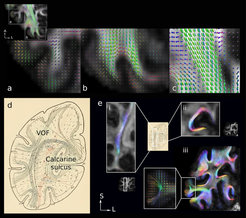A multi-modal approach to in vivo U-fibre mapping in the early visual processing stream
Short cortico-cortical association fibres (U-fibres) are white matter fibres that run directly below the cortical grey matter in the superficial white matter and connect nearby cortical areas. U-fibres have demonstrated involvement in brain development, function and pathology but are underrepresented in the current human brain connectome. A more complete picture of the human brain connectome can be obtained by reliably mapping the U-fibres, but this requires high quality sub-millimetre resolution in vivo diffusion MRI, dedicated fibre and tractography models and appropriate validation.
We addressed U-fibre connectivity mapping by acquiring sub-millimetre resolution in vivo diffusion MRI facilitated by the high performance gradients (300 mT/m maximum gradient amplitude) of the 3T Connectom scanner (Siemens Healthineers, Erlangen, Germany) and targeted validation via mapping U-fibre connectivity in the human brain between the primary and secondary visual cortical areas (V1 and V2, respectively) which are known to be retinotopically organised. The detected U-fibre connectivity maps were found to be retinotopically organised, i.e., connections between corresponding retinotopic areas of V1 and V2 were relatively higher.
This proof-of-concept study showcases robust U-fibre connectivity mapping in vivo. We believe that the current research effort — combining multiple MRI modalities for U-fibre mapping and validation — is an essential step toward the construction of a more complete human brain connectome.
Related publications:
Movahedian Attar F, Kirilina E, Haenelt D, Trampel R, Edwards L J, Weiskopf N. 2020. Mapping Short Association Fibers in the Early Cortical Visual Processing Stream Using In Vivo Diffusion Tractography. Cerebral Cortex. doi: 10.1093/cercor/bhaa049













